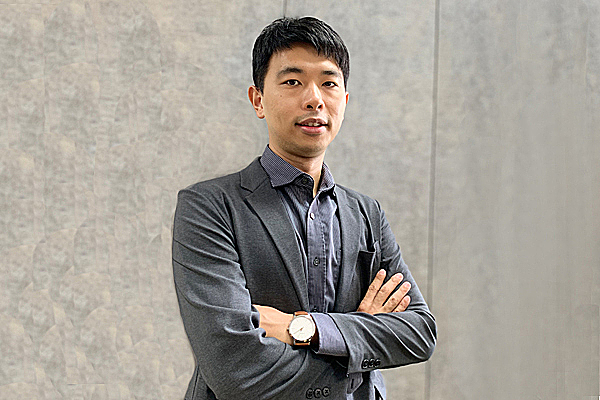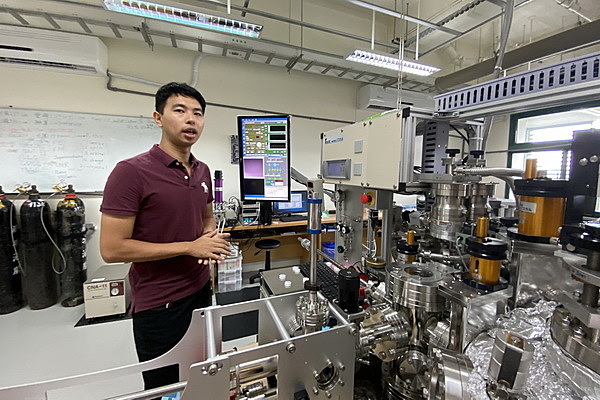Associate professor Jan-Chi Yang of the Department of Physics at NCKU received the 8th Outstanding Young Scholar Award from the Foundation for the Advancement of Outstanding Scholarship and the Yu‐Ziang Hsu Scientific Paper Award. At thirty-three years old, he made a technological breakthrough in optical control of multi-bit memory configuration that does not require conventional electrical circuits. This achievement was published in a top international journal - Nature Materials.
With his tall and thin physique, Professor Yang looks more like a student than a professor. His commitment and dedication to his research shines through his youthful appearance. When he becomes immersed in his research, he tends to forget to eat and sleep. After studying materials science and engineering at National Chiao Tung University in its undergraduate and master’s programs, he went to the Lawrence Berkeley National Laboratory, where he specialized in multiferroics, laser molecular beam epitaxy, complex oxides, quantum materials, and material physics. In 2009, Jan-Chi Yang delved into the field of laser molecular beam epitaxy while pursuing his doctoral degree. A full decade into his journey, he made waves in the world of academia.

Associate professor Jan-Chi Yang receives Outstanding Young Scholar Award from Foundation for the Advancement of Outstanding Scholarship
Crossing from materials science into physics, Professor Yang has always liked to go his own way. Before university, one of his dreams was to become a full-time professor; the other was to become a doctor. However, he missed getting into medical school by only 3 points in his college entrance exam. Although he could have studied dentistry, a congenital spine issue forced him to give up on that idea. “Most people have a curve to their spines, but mine is pretty straight, so I’m prone to pinched nerves. If I read with my head down, my neck starts to hurt after just three minutes. I often had to get injections for pain relief as a high-school student.”
His aspirations were influenced by his family background. His father, who only had a high-school diploma, worked as a technician at the National Chung-Shan Institute of Science and Technology, and his mother was a full-time housewife who worked part-time from home. The costs of raising three children demanded sacrifices from his parents. “I wanted to become a doctor or a professor so that, even if I didn’t make a lot of money, my parents would be proud of me.”
Although his congenital condition prevented him from becoming a doctor, he discovered an even greater interest in the field of materials. “I was fascinated by materials science and fundamental physics, but I wasn’t interested in merely adjusting parameters or improving material properties; I wanted to change materials at the smallest atomic level and create and synthesize new materials.” He had always enjoyed being hands-on and exploring; as such he accumulated knowledge and experience in various areas during university. However, the person who really spurred him on was his doctoral supervisor, Ying-Hao Chu.
“Professor Ying-Hao Chu had a great impact on me. He is the only person in Taiwan who has been awarded the title of highly cited researchers for eight consecutive years, and I was his first doctoral student. He taught me how to learn and do research and what education means.” Professor Yang and his research team used the multiferroic material bismuth ferrite to successfully achieve non-contact optical control data storage without the need for traditional circuit. He received international recognition for this work.
Professor Yang explained that at present, memory reading and writing requires voltage to alter material states. The critical optical control technology developed by their research team uses light to storage information. Without the need for complex circuit designs, it can control multi-digit memory states, thereby greatly reducing memory volume. Assisted by optical control of multifunctionality, Professor Yang and their team aim for the renovation of quantum storage and quantum communication from materials point of view. Professor Yang said that the greatest significance of this research is the ability to begin designing from the atomic level and control the crystal structure and physical properties of materials. This achievement lets the everyone know that even though Taiwan might be small, it can leverage its advantages and boundless creativity to take the lead in the development of next-generation critical materials and technologies.
Professor Yang also acknowledged the invaluable contributions of his research team, which mostly consists of faculty members and students at NCKU, as well as those of his close research partners in Germany and the US. He thanked the National Synchrotron Radiation Research Center for providing researchers with a unique synchrotron radiation research platform. He gave special thanks to NCKU and the Ministry of Science and Technology (MOST) for strongly supporting the establishment of the most advanced laser molecular beam epitaxy platform. NCKU in particular invested substantial resources in the early stages of his research, creating a state-of-the-art research platform.
Professor Yang said that it can be difficult for a new researcher to obtain such funding, but NCKU is willing to invest where and whom they see potential. He also thanked MOST’s Einstein Program, which is dedicated to cultivating talent among under-35-year-olds. When he began this work, Yang only had enough money for equipment, and it was the funding from this program that enabled his research team to continue their work.
“There was this feeling of unity in our department, that we had help and were not alone.” Professor Yang’s life philosophy is “Pick one thing and give it your all”. For new professors, the greatest difficulty is getting enough papers published so they can advance themselves. Yang chose a different path, not publishing his first paper until three years after his laboratory opened. This is hard to imagine for many people, but he had a plan and he stuck to it.
Before Professor Yang came to NCKU, he passed up the opportunity to stay in the US. Teaching and doing research at NCKU these past years while fielding several high-paying job offers in China, Professor Yang has gained a clear idea of the true value of university education. He said that he is full of anticipation regarding the future and hopes that he can find ways to make meaningful contributions. His highest hopes remain with his students. “The greatest honor is the opportunity to teach and influence young minds. This I learnt from my advisor.”
【Furhter Reading】
The Y. Z. Hsu Science Awards is an iconic award in the field of science and technology in Taiwan. In 2020, researchers at NCKU won a total of four awards, the highest number in recent years. With their outstanding academic performance and contributions, these four researchers are facilitating industrial innovation and improving the technological competitiveness of Taiwan.
The Far Eastern Y. Z. Hsu Science and Technology Memorial Foundation, the first private foundation to be established with the approval of the National Science Council (predecessor of MOST), actively promotes domestic innovation in science and technology and rewards scientific talent. Each year, they hand out the Y. Z. Hsu Scientific Awards at a lavish awards ceremony. The annual awards include 5 Science Chair Professor Awards and 12 Science Paper Awards. Every two years, 6 awards are given for Technology Invention. This year, NCKU took home four awards, an impressive achievement.
Associate Professor in the Department of Physics and member of the Center for Quantum Frontiers of Research and Technology (QFort), Jan-Chi Yang won the Y. Z. Hsu Science Paper Award for nanotechnology. He is also one of the young researchers supported by MOST’s Einstein Program, a notable achievement. Specializing in material physics, Professor Yang and his research team developed a critical optical control technology that can be used to simultaneously modulate multi-digit memory configurations using bismuth ferrite (BiFeO3). A single BiFeO3 atomic cell has 8 memory configurations and excellent stability in temperatures far higher than room temperature. This innovation will greatly increase data storage density and reduce energy consumption.
Accompanying the development of artificial intelligence, big data, and quantum computers is the need for memory technology enabling massive data storage and swift access. Professor Yang indicated that multi-digit memory technology with large density, miniaturized volume and low energy dissipation in conjunction with high-speed computation will greatly benefit research into the Internet of Things, artificial intelligence, and quantum computing.
